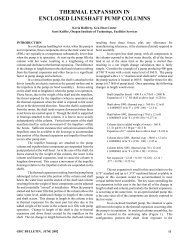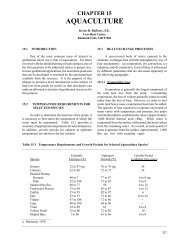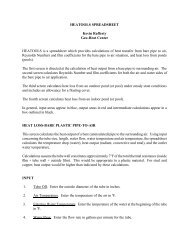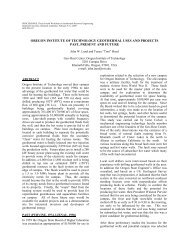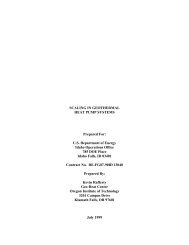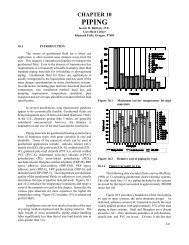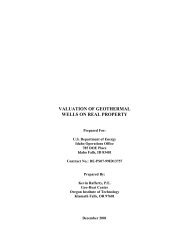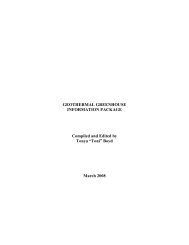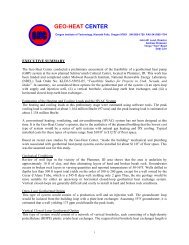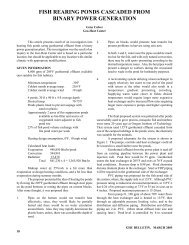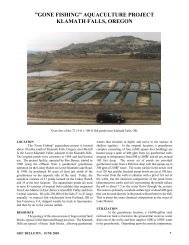Geothermal Heat Pump Utilization in the United ... - Geo-Heat Center
Geothermal Heat Pump Utilization in the United ... - Geo-Heat Center
Geothermal Heat Pump Utilization in the United ... - Geo-Heat Center
You also want an ePaper? Increase the reach of your titles
YUMPU automatically turns print PDFs into web optimized ePapers that Google loves.
Introduction<br />
GEOTHERMAL HEAT PUMP UTILIZATION<br />
IN THE UNITED STATES<br />
John W. Lund, Research Associate<br />
<strong>Geo</strong>-<strong>Heat</strong> <strong>Center</strong><br />
Air source heat pumps have been used for many years, but due to <strong>the</strong> constant temperature of ground<br />
water, water source heat pumps became popular <strong>in</strong> <strong>the</strong> 1970s. This was promoted <strong>in</strong> part by <strong>the</strong> National<br />
Water Well Association of Dubl<strong>in</strong>, Ohio. Due to cheap drill<strong>in</strong>g methods, earth coupled closed loop heat pump<br />
systems ga<strong>in</strong>ed <strong>in</strong> popularity <strong>in</strong> <strong>the</strong> 1980s. The latter consist of ei<strong>the</strong>r vertical or horizontal <strong>in</strong>stallations of<br />
a closed loop heat exchanger. The vertical <strong>in</strong>stallation normally uses a 4-<strong>in</strong>ch diameter hole, <strong>in</strong> which two<br />
one-<strong>in</strong>ch diameter plastic pipes are placed and grouted. Drill<strong>in</strong>g and pip<strong>in</strong>g costs are around $2.50 per foot.<br />
A rule of thumb is to use 100 to 150 foot of hole for each 12,000 Btu/hr peak load required. S<strong>in</strong>ce most<br />
residences require around 3 tons of cool<strong>in</strong>g or heat<strong>in</strong>g load, up to 450 feet may be required. The national<br />
average is 150 to 200 feet per bore. Water with ethylene glycol is circulated <strong>in</strong> <strong>the</strong> system. In areas where<br />
drill<strong>in</strong>g is difficult or expensive, horizontal closed loops are used; buried four to five feet below <strong>the</strong> surface.<br />
These loops are generally longer than <strong>the</strong> vertical loops, and use extensive surface land area. In some states,<br />
ponds are used as <strong>the</strong> heat source or heat s<strong>in</strong>k. The pipes are placed on <strong>the</strong> bottom of <strong>the</strong> pond, which are<br />
generally at least eight feet deep. The Internationsl Ground Source <strong>Heat</strong> <strong>Pump</strong> Association, located on <strong>the</strong><br />
Oklahoma State University Campus at Stillwater, is <strong>the</strong> ma<strong>in</strong> promoter of earth coupled systems.<br />
Recent developments <strong>in</strong> earth coupled systems use a refrigerant, ra<strong>the</strong>r than water/antifreeze, that is<br />
circulated through <strong>the</strong> buried pipes. This system extends <strong>the</strong> refrigerant loop of <strong>the</strong> heat pump <strong>in</strong>to <strong>the</strong><br />
ground, elim<strong>in</strong>at<strong>in</strong>g <strong>the</strong> heat exchanger and circulation pump between <strong>the</strong> water/antifreeze loop and <strong>the</strong><br />
refrigerant loop. The buried copper pipes become a giant evaporator <strong>in</strong> w<strong>in</strong>ter and a condenser <strong>in</strong> summer.<br />
The buried pipes, are placed <strong>in</strong> 1¼ <strong>in</strong>ch diameter holes, typically 60 feet deep. It normally takes three such<br />
holes for each ton (12,000 Btu) of heat pump capacity. Prelim<strong>in</strong>ary tests <strong>in</strong>dicate <strong>the</strong> net effect is a 15 to 20%<br />
efficiency ga<strong>in</strong> over water/antifreeze system. (Popular Science, June 1988).<br />
Ground water and earth coupled systems (vertical configuration) depended upon <strong>the</strong> average ground water<br />
temperature. The temperature of <strong>the</strong> ground and ground water below 100 feet is controlled by <strong>the</strong> geo<strong>the</strong>rmal<br />
gradient and thus are considered geo<strong>the</strong>rmal. The horizontal earth coupled and surface pond systems are<br />
<strong>in</strong>fluenced by solar radiation due to <strong>the</strong>ir shallow placement. Only data for <strong>the</strong> former two are considered,<br />
and only <strong>the</strong> ground water systems are used to determ<strong>in</strong>e ground water pump<strong>in</strong>g usage. Generally three<br />
gallon per m<strong>in</strong>ute per ton of heat<strong>in</strong>g or cool<strong>in</strong>g load is required. A typical value for a residential location of<br />
3 tons is 8 gpm with a temperature drop of 10 °F.<br />
When calculat<strong>in</strong>g energy use, load factors are considered for <strong>the</strong> heat<strong>in</strong>g mode only, s<strong>in</strong>ce this extracts heat<br />
from <strong>the</strong> earth. In determ<strong>in</strong><strong>in</strong>g <strong>the</strong> approximate annual energy use, a load factor of 0.10 is used for <strong>the</strong><br />
sou<strong>the</strong>rn states with ground water temperature above 60°F; a factor of 0.20 used for <strong>the</strong> central states, and<br />
0.30 for <strong>the</strong> nor<strong>the</strong>rn states where <strong>the</strong> ground water temperature is below 50°F (See Figure 1). In <strong>the</strong><br />
sou<strong>the</strong>rn states, cool<strong>in</strong>g loads control <strong>the</strong> size of <strong>the</strong> system, whereas <strong>in</strong> <strong>the</strong> nor<strong>the</strong>rn states heat<strong>in</strong>g is <strong>the</strong><br />
controll<strong>in</strong>g factor. The heat<strong>in</strong>g loads for various sites <strong>in</strong> <strong>the</strong> U.S. us<strong>in</strong>g this procedure are listed <strong>in</strong> Table 1.
Table 1. -<strong>Heat</strong><strong>in</strong>g loads for various sites.<br />
State Site Temp. Capacity Annual Energy<br />
(F) (Million Btu/h) (Billion Btu/y)<br />
FL All of State 75 800.0 700.8<br />
MI All of State 47 135.0 354.8<br />
IN All of State 54 187.2 328.0<br />
OH All of State 53 129.6 227.0<br />
WI All of State 46 720.0 189.2<br />
IL All of State 54 100.8 176.6<br />
KY All of State 59 88.2 154.5<br />
FL Patrick Air Force Base 72 39.6 138.8<br />
TX All of State 67 147.9 129.6<br />
PA All of State 50 68.4 119.8<br />
MN All of State 45 36.0 94.6<br />
MD All of State 57 46.8 82.0<br />
NC All of State 63 91.8 80.4<br />
LA All of State 69 90.0 78.8<br />
AR All of State 63 75.6 66.2<br />
VA All of State 59 36.0 63.1<br />
SC All of State 67 61.2 53.6<br />
UT LDS Office Build<strong>in</strong>g 60 27.0 47.3<br />
ND All of State 42 18.0 47.3<br />
MO All Of State 57 54.0 47.3<br />
NB Nor<strong>the</strong>rn Part of State 52 23.4 41.0<br />
NJ All Of State 55 23.4 41.0<br />
IA All of State 52 23.4 41.0<br />
DE All of State 57 20.5 35.9<br />
SD All of State 47 13.5 35.5<br />
NY All of State 47 11.2 29.3<br />
GA All of State 67 24.5 21.4<br />
SD St. Joseph Indian School 73 7.7 20.6<br />
ID College of Sou<strong>the</strong>rn Idaho 102 8.2 18.0<br />
TN All of State 61 17.6 15.4<br />
KS All of State 57 8.0 14.0<br />
WA Clark College 55 6.8 13.8<br />
CO All of State 52 7.2 12.6<br />
NY Sagamore Resort 46 4.2 11.0<br />
WA Grant Country Courthouse 84 3.7 8.4<br />
IN Corporate Square 55 4.2 7.4<br />
WA Yakima County Jail 76 3.6 7.3<br />
AL All of State 67 8.3 7.3<br />
WA Ch<strong>in</strong>ook Tower 60 3.1 6.6<br />
WA Cowlite Co. Courthouse 55 3.0 6.0<br />
WA Sundown M Ranch 70 1.8 3.7<br />
MS All of State 67 4.0 3.5<br />
KS Elementary Schools (3) 59 4.7 3.3<br />
AZ All of State 62 3.6 3.2<br />
ND Buxton School 42 1.2 3.2<br />
OR Thunderhead Lodge 68 1.2 2.3<br />
NV Carl<strong>in</strong> High School 87 0.9 2.0<br />
PA Factory at Masontown 52 1.0 1.7<br />
NV Wells High School 87 0.8 1.6<br />
OK Central Part of State 62 1.2 1.0<br />
MA English High School 55 0.4 0.9<br />
MS Mississippi Power Co. 69 1.1 0.9<br />
MS Commercial Build<strong>in</strong>gs 59 1.1 0.9<br />
NB Homestead National Monument 58 0.2 0.3<br />
WA Casey House 70 0.1 0.2<br />
WA Adams Co. Fire Station 80 0.2 0.2
Figure 1. – Average ground water temperature and heat<strong>in</strong>g load factor map. Values used for heat pump<br />
analysis.<br />
At <strong>the</strong> present time, earth coupled heat pump systems are be<strong>in</strong>g <strong>in</strong>stalled <strong>in</strong> great numbers; however, ground<br />
water systems are still popular. It is estimated that almost 50,000 ground water systems and over 30,000<br />
closed loop, earth coupled systems (2/3 of <strong>the</strong>se are vertical <strong>in</strong>stallations and 1/3 horizontal) are be<strong>in</strong>g used<br />
<strong>in</strong> <strong>the</strong> <strong>United</strong> States (ma<strong>in</strong>ly <strong>in</strong> <strong>the</strong> midwest and east). Over 6,000 earth coupled systems are placed <strong>in</strong> Canada<br />
(M<strong>in</strong>istry of Energy, M<strong>in</strong>es and Resources, Ottawa- Solar Division). This year <strong>the</strong>re will be over 10,000 earth<br />
coupled and 8,000 ground water systems <strong>in</strong>stalled <strong>in</strong> <strong>the</strong> <strong>United</strong> States, a 50% <strong>in</strong>crease over last year. The<br />
popularity of <strong>the</strong>se systems is due to <strong>the</strong> recent promotion by electric utility companies throughout <strong>the</strong><br />
country, aga<strong>in</strong> ma<strong>in</strong>ly <strong>in</strong> <strong>the</strong> midwest and east. It has national appeal s<strong>in</strong>ce ground water temperatures down<br />
to 39°F can be used <strong>in</strong> heat pump systems.<br />
It is more difficult to estimate cool<strong>in</strong>g energy than heat<strong>in</strong>g energy, as cool<strong>in</strong>g loads depend upon many<br />
factors such as solar loads, latent loads, outdoor temperature, and <strong>in</strong>ternal loads such as due to light<strong>in</strong>g and<br />
<strong>the</strong> occupants, ra<strong>the</strong>r than on a s<strong>in</strong>gle major factor found <strong>in</strong> heat<strong>in</strong>g. The equivalent full load hours method<br />
is commonly used to estimate <strong>the</strong> cool<strong>in</strong>g load (ASHRAE). This method is used <strong>in</strong> <strong>the</strong> article.<br />
The energy associated with ground and water source heat pumps <strong>in</strong> <strong>the</strong> cool<strong>in</strong>g mode can be viewed from<br />
two completely different perspectives;1) <strong>the</strong> energy saves as compared to air source equipment, and 2) <strong>the</strong><br />
total energy delivered <strong>in</strong>to <strong>the</strong> ground or ground water. The former sav<strong>in</strong>gs can be used to estimate energy<br />
sav<strong>in</strong>gs <strong>in</strong> terms of equivalent barrels of oil after correct<strong>in</strong>g for <strong>the</strong> efficiency of <strong>the</strong> plant, etc. The latter is<br />
not a sav<strong>in</strong>gs and has no beneficial use, except that some of it can be extracted dur<strong>in</strong>g <strong>the</strong> next heat<strong>in</strong>g season<br />
by revers<strong>in</strong>g <strong>the</strong> operation of <strong>the</strong> heat pump. For many ground water heat pump systems <strong>the</strong> discharge water<br />
is not returned to <strong>the</strong> ground, but <strong>in</strong>stead disposed of to surface dra<strong>in</strong>age, ponds, pools, or used for water<strong>in</strong>g<br />
lawns.<br />
The energy saved as compared to air source equipment is dependent upon <strong>the</strong> temperature of <strong>the</strong> ground<br />
or ground water as compared to <strong>the</strong> air, and <strong>the</strong> equivalent full load hours. The latter number is based on <strong>the</strong><br />
amount of time cool<strong>in</strong>g is used dur<strong>in</strong>g an average year converted to an equivalent number of full load hours
per year. Sou<strong>the</strong>rn states would have higher values as compared to nor<strong>the</strong>rn states; however, nor<strong>the</strong>rn states<br />
would save more energy per operat<strong>in</strong>g hour s<strong>in</strong>ce <strong>the</strong> colder ground or ground water temperature is more<br />
efficient for heat pump operation. Table 2 reports <strong>the</strong> energy sav<strong>in</strong>gs for <strong>the</strong> cool<strong>in</strong>g portion of <strong>the</strong> heat<br />
pumps.<br />
Table 2.-<strong>Heat</strong> <strong>Pump</strong> Cool<strong>in</strong>g Load Sites <strong>in</strong> <strong>the</strong> <strong>United</strong> States.<br />
State Site Major Res. Temp Capacity <strong>Heat</strong> to Ground Energy Sav<strong>in</strong>gs<br />
Appl. Type (F) (tons) (billion Btu/y) (billion Btu/y)<br />
AL All of State HP 67 690.0 18.2 0.3<br />
AR All of State HP 63 6300.0 185.5 4.1<br />
AZ All of State HP 62 300.0 9.3 0.2<br />
CO All of State HP 52 600.0 5.6 0.2<br />
DE All of State HP 57 1710.0 21.2 0.8<br />
FL All of State HP 75 60000.0 1953.0 8.6<br />
FL Patrick Air Force Base HP 72 3303.0 107.5 0.5<br />
GA All of State HP 67 2040.0 41.1 0.6<br />
IA All of State HP 52 1950.0 24.2 1.1<br />
IL All of State HP 54 8400.0 143.2 5.7<br />
IN All of State HP 54 15600.0 266.0 10.5<br />
IN Corporate Square HP 55 350.0 6.0 0.2<br />
KS All of State HP 57 600.0 12.1 0.4<br />
KY All of State HP 59 7350.0 142.4 4.4<br />
LA All of State HP 69 7500.0 244.1 2.7<br />
MA English High School HP 55 35.0 0.4 0.0<br />
MD All of State HP 57 3900.0 57.4 2.0<br />
MI All of State HP 47 11250.0 139.5 7.7<br />
MN All of State HP 45 3000.0 27.9 1.6<br />
MO All of State HP 57 4500.0 90.7 3.2<br />
MS All of State HP 67 300.0 7.9 0.1<br />
MS Mississippi Power Company HP 69 89.0 2.5 0.0<br />
MS Commercial Build<strong>in</strong>g HP 69 84.0 2.3 0.0<br />
NB All of State HP 52 1950.0 24.2 1.1<br />
NB Homestead National Monument HP 58 14.0 0.3 0.0<br />
NC All of State HP 63 7650.0 106.7 2.6<br />
ND All of State HP 42 1500.0 11.6 0.7<br />
NJ All of State HP 55 1950.0 21.2 0.8<br />
NV Carl<strong>in</strong> & Wells High Schools HP 87 171.0 1.8 0.0<br />
NY All of State HP 47 932.0 8.6 0.5<br />
NY Sagamore Resort HP 46 350.0 3.2 0.2<br />
NY East Middle Sch. & C.C HP 125 0.0 0.0 0.0<br />
OH All of State HP 53 10800.0 167.4 7.0<br />
OK All of State HP 62 90.0 2.4 0.1<br />
OR Thunderhead Lodge HP 68 109.0 1.2 0.0<br />
PA All of State HP 50 5700.0 92.8 4.5<br />
PA Factory HP 52 80.0 1.4 0.1<br />
SC All of State HP 67 5100.0 102.8 1.6<br />
SD All of State HP 47 1125.0 15.7 0.9<br />
TN All of State HP 61 1470.0 29.6 0.7<br />
TX All of State HP 67 12150.0 268.9 4.1<br />
UT LDS Office Build<strong>in</strong>g HP 60 2250.0 24.4 0.7<br />
VA All of State HP 59 3000.0 44.2 1.4<br />
WA All of State HP 70 2188.0 23.7 0.2<br />
WI All of State HP 46 6000.0 65.1 3.7<br />
Grand Total 204430.0 4525.1 85.8
Estimation Methods<br />
The energy use reported <strong>in</strong> Table 1 is primarily developed from personal communication with key persons<br />
<strong>in</strong> each state.<br />
In case of heat pumps wells used for heat<strong>in</strong>g, it was assumed that an average residence would require a<br />
temperature drop of 10°F at 8 gpm to meet <strong>the</strong> <strong>the</strong>rmal capacity of an 1,800 ft 2 home.<br />
In Alabama, for example, an estimated 100 heat pump wells are used for space heat<strong>in</strong>g. The estimated<br />
<strong>the</strong>rmal capacity for <strong>the</strong> heat load only is:<br />
q = (100) (8.33 lbm/gal)(60m<strong>in</strong>/hr)(8gpm)(60°F-50°F)(1.0 Btu/lbm/°F)<br />
q = 4.0 X 10 6 Btu/hr<br />
and <strong>the</strong> estimated annual energy use, based on a load factor of 0.10 for heat<strong>in</strong>g only is:<br />
AE = (0.10)(8760 h/yr)(4.0 X 10 6 Btu/hr)<br />
AE = 3.5 X 10 9 Btu/yr<br />
The energy sav<strong>in</strong>gs for ground water heat pump cool<strong>in</strong>g are estimated by <strong>the</strong> follow<strong>in</strong>g procedures:<br />
1. Data on three-ton cool<strong>in</strong>g units (<strong>the</strong> most common size used <strong>in</strong> <strong>the</strong> <strong>United</strong> States) were obta<strong>in</strong>ed<br />
from <strong>the</strong> Air Condition<strong>in</strong>g and Refrigeration Institute (ARI) Directory of Certified Equipment, for<br />
a) air source units us<strong>in</strong>g 95°F outside air, and b) water source units us<strong>in</strong>g ground water at 50°F and<br />
70°F. The latter values were corrected for pump<strong>in</strong>g energy used to lift <strong>the</strong> water from <strong>the</strong> well. The<br />
average Energy Efficiency Ration (EER) for <strong>the</strong> air source equipment <strong>in</strong> <strong>the</strong> cool<strong>in</strong>g mode is 9.2<br />
Btu/Watt, and for <strong>the</strong> water source unit 11.1 and 9.5 Btu/Watt respectively (12.3 and 10.4 before<br />
correction). The sav<strong>in</strong>gs, us<strong>in</strong>g water source over air source equipment is <strong>the</strong> difference between <strong>the</strong><br />
above figures and when converted to a sav<strong>in</strong>gs of kW/ton is 0.22 kW/ton at 50°F and 0.04 kW/ton<br />
at 70°F. The relationship assumed to be approximately l<strong>in</strong>ear, thus values at o<strong>the</strong>r ground water<br />
temperature (not available <strong>in</strong> ARI) are <strong>in</strong>terpolated.<br />
2. Estimates of Equivalent Full Load Hours were obta<strong>in</strong>ed from a list of cities <strong>in</strong> <strong>the</strong> 1985 ASHRAE<br />
Fundamentals, Chapter 28. The value for each state was obta<strong>in</strong>ed by averag<strong>in</strong>g results from cities <strong>in</strong><br />
<strong>the</strong> state or from nearby cities of similar wea<strong>the</strong>r characteristics.<br />
3. The sav<strong>in</strong>gs <strong>in</strong> energy by us<strong>in</strong>g a ground water heat pump over an air source heat pump is <strong>the</strong><br />
sav<strong>in</strong>gs value <strong>in</strong> kW/ton based on <strong>the</strong> average ground water temperature as determ<strong>in</strong>ed from <strong>the</strong> map<br />
(Figure 1). Us<strong>in</strong>g <strong>the</strong> State of Delaware as an example: average ground water temperature = 57°F<br />
giv<strong>in</strong>g a sav<strong>in</strong>gs of 0.16 kW/ton; <strong>the</strong> equivalent full load hours determ<strong>in</strong>ed from ASHRAE is<br />
approximately 800 hrs/yr; and 570 ground water and earth coupled heat pump <strong>in</strong>stallations, each with<br />
an average of a three-ton cool<strong>in</strong>g unit. The sav<strong>in</strong>gs is:<br />
(570 <strong>in</strong>stallations)( 3 tons/<strong>in</strong>stallations)(800 hrs/yr)(0.16 kW/ton)(3413 Btu/hr-kW)<br />
=0.75 x 10 9 Btu/yr (sav<strong>in</strong>gs)
4. The heat delivered to <strong>the</strong> ground or ground water by <strong>the</strong> heat pump is <strong>the</strong> sum of <strong>the</strong> capacity of<br />
each <strong>in</strong>stallation at three tons (12,000 Btu/hr-ton capacity) plus <strong>the</strong> compressor energy. The<br />
compressor energy varies between 12.3 Btu/Watt at 50°F to 10.4 Btu/Watt at 70°F, or 0.976 kW/ton<br />
and 1.154 kW/ton respectively. An average of slightly over 1.00 kW/ton or: (1.00 kW/ton) (3413<br />
Btu/hr kW) = 3500 Btu/hr-ton will be used. Aga<strong>in</strong> us<strong>in</strong>g <strong>the</strong> State of Delaware as an example.<br />
(570 <strong>in</strong>stallations)(3tons/<strong>in</strong>stallations)(800 hrs/yr)(12,000 Btu/hr-ton + 3500 Btu/hr-ton)<br />
= 21.2 x 10 9 Btu/yr (<strong>in</strong>to ground)<br />
In all cases <strong>the</strong> energy sav<strong>in</strong>gs is far less than <strong>the</strong> energy delivered <strong>in</strong>to <strong>the</strong> ground as shown <strong>in</strong> Table 2.<br />
Summary of <strong>Heat</strong> <strong>Pump</strong> Characteristics<br />
1. Air source units as compared to those us<strong>in</strong>g heat from <strong>the</strong> ground are less expensive, and s<strong>in</strong>ce<br />
<strong>the</strong> technology has been around longer, it is easier to f<strong>in</strong>d contractors and <strong>in</strong>stallers. They also do<br />
not require drill<strong>in</strong>g or excavations to place pipes. The disadvantages are higher operation and<br />
ma<strong>in</strong>tenance costs and lower efficiency (COP). The outdoor unit is exposed to snow build-up,<br />
corrosion (especially critical <strong>in</strong> <strong>the</strong> salt air), and vandalism. A backup electrical resistance heat<strong>in</strong>g<br />
unit is required for heat<strong>in</strong>g <strong>in</strong> colder climates.<br />
2. Ground Source (both ground water and earth coupled) units as compared to air source units are<br />
more efficient (COP) and provide better performance s<strong>in</strong>ce <strong>the</strong> heat source rema<strong>in</strong>s at nearly a<br />
constant temperature all year. Generally no backup heat<strong>in</strong>g unit is required. They have <strong>the</strong><br />
disadvantage of be<strong>in</strong>g more complicated and thus more expensive. They also require drill<strong>in</strong>g or<br />
excavation to place <strong>the</strong> pip<strong>in</strong>g. The ground water units require larger bores and cas<strong>in</strong>g along with<br />
water pumps. Corrosion and water disposal are also a concern.<br />
Some o<strong>the</strong>r advantages and disadvantages of <strong>the</strong>se systems are shown <strong>in</strong> Table 3.<br />
(Ref. DOE/CE/15095-6/ Dec. 1983).<br />
Acknowledgements<br />
Much of <strong>the</strong> <strong>in</strong>formation for this paper was provided by Dan Ellis, President of <strong>the</strong> International Ground<br />
Source <strong>Heat</strong> <strong>Pump</strong> Association (IGSHPA), and Vice President of Market<strong>in</strong>g, Waterfurnace International,<br />
Inc., Ft. Wayne, IN; Kev<strong>in</strong> McCray, National Water Well Association, Dubl<strong>in</strong>, OH; Bob Weaver, Executive<br />
Director, IGSHPA, Stilwater, OK; and Harry Braud, Agricultural Eng<strong>in</strong>eer<strong>in</strong>g Dept., Louisiana State Univ.,<br />
Baton Rogue, LA.
Table 3.- Advantages and disadvantages of earth-coupled and water-coupled systems.<br />
System Advantage Disadvantages<br />
Earth tubes No energy or low energy consumption Limited areas where <strong>the</strong>y can be used<br />
effectively<br />
Earth coil with heat pump Relatively low energy consumption<br />
Water-coupled system with heat<br />
exchanger<br />
Surface water-coupled system<br />
with heat pump<br />
Ground water-coupled system<br />
with heat pump<br />
Moderate operat<strong>in</strong>g costs<br />
Better performance than air-to-air heat<br />
pumps<br />
Lower <strong>in</strong>itial cost than for heat pump<br />
Lower operat<strong>in</strong>g cost than for heat<br />
pump<br />
<strong>Heat</strong> source/s<strong>in</strong>k temperatures are<br />
relatively constant compared with air<br />
Good energy efficiency<br />
Moderate operat<strong>in</strong>g cost<br />
Does not require defrost cycle like airsource<br />
heat pump<br />
May not require supplemental heat<br />
<strong>Heat</strong> source/s<strong>in</strong>k temperatures are<br />
relatively constant<br />
Good energy efficiency<br />
Does not require defrost cycle like airsource<br />
heat pump<br />
Moderate operat<strong>in</strong>g cost<br />
May not require supplemental heat<br />
Moisture, verm<strong>in</strong>, or radon <strong>in</strong> tubes may<br />
be problems<br />
Dry earth is not as good as water as a<br />
source/s<strong>in</strong>k<br />
High <strong>in</strong>itial cost<br />
leaks difficult to f<strong>in</strong>d and repair<br />
<strong>Pump</strong><strong>in</strong>g cost<br />
Limited areas where <strong>the</strong>y can be used<br />
effectively<br />
Requires thorough understand<strong>in</strong>g of<br />
design factors<br />
Suitable water bodies are limited<br />
System clogg<strong>in</strong>g, foul<strong>in</strong>g, scal<strong>in</strong>g, or<br />
corrosion<br />
Current or wave action can damage<br />
equipment<br />
High <strong>in</strong>itial cost<br />
<strong>Pump</strong><strong>in</strong>g cost<br />
High <strong>in</strong>itial cost<br />
Scal<strong>in</strong>g or corrosion can be problems<br />
<strong>Pump</strong><strong>in</strong>g cost



